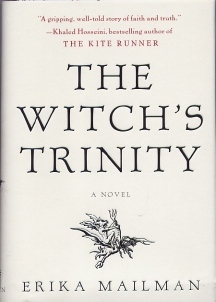A great novel can reconcile seemingly incompatible intentions. Readers
can be enchanted and entertained, gripped by tense plotting, horrified
by surreal visions of terror and still walk away having learned a
fact or two in a manner by virtue of which the learning itself is
a pleasure. It's not easy to walk this tightrope. Exciting plots
tend to feel forced; informative revelations more so. Combining the
two seems easy but is known to be almost impossibly difficult. 'The
Witch's Trinity' by Erika Mailman succeeds on both levels with prose
that is often surreal and yet always a model of clarity. We enjoy
reading between the lines, seeing aspects of a novel's reality that
the characters may speak of but do not comprehend. To be sure, 'The
Witch's Trinity' is an effective horror novel, teasing scares out
of supernatural horror and all-too-real historical violence. More
than that, however, it is a cunning historical vision that allows
the reader to enjoy the fruits of modern knowledge. Plot points the
characters cannot possibly grasp are easily understood by the reader,
adding a unique level of educational enjoyment to the reading experience.
This book scares you and makes you feel smart.
The novel begins in a famine, and hunger plays a key role in a variety
of situations. It's winter in Tierkindorf, a remote village in 16th century
Germany. Güde Muller has lived beyond her years, and her daughter-in-law
Irmeltrude is resentful. The situation is desperate. When a fat, well-fed
friar comes to town armed with the latest in witchfinding technology,
the Malleus Maleficarum, a book that gives detailed instructions on how
to identify the enemy within, hope springs forth. The famine is clearly
due to the presence of one or more witches. Once the evil is identified – and
burned alive – the problem is solved. But one good scapegoat deserves
another.
Mailman writes the novel in the first person, from Güde's perspective.
She's careful to hang back, keep the prose clean and Güde's understanding
of the situation limited. Thus, it's all the more effective when Irmeltrud
locks Güde out of the house. Left to wander alone the forest, Güde
encounters a horrific batch of very traditional witches. But Mailman
effectively writes from the perspective of the ignorant, superstitious
old woman who is terrified by what she sees. It's a bravura piece of
writing, full of awe taken to the point of fear. But what follows, grounded
in the real world, is more frightening, and frighteningly relevant in
the post-9/11 era.
Mailman creates a large cast of characters and manages them well through
some surprising, but not unrealistic changes. Irmeltrude is particularly
complicated and though thoroughly unlikable as a human being, a delightful
character. Mailman does well by the male characters in the novel as well.
You can practically smell the sweat on the friar's brow as he prepares
the fire. Güde's son, Jost, is pragmatic but not overly wise. Ramwold,
the rune-caster, was particularly fascinating in a historical context.
By our standards these people are all superstitious rubes. But Mailman
manages to invest them with enough heft so that they have the rough-hewn
feel of real men and women, not costumed characters in a dress-up drama.
The scenes of horror are varied and all handled with amazing skill. Witchery
has never seemed so evil, so delicious, so unpleasantly real. Mailman
does not go for a lot of ostentatious frills here. She doesn't over-invent
and resists the urge to over-write. By virtue of the first-person ignorant
observer's perspective, she takes the basic and makes it truly terrifying.
And when the time comes to break out the torture devices, she's smart
enough to know that in some cases, one need only show, not tell.
Even if you think you can figure out where the plot is going, Mailman
manages a number of surprising turns to match the terrifying content.
For a novel that takes place in a rude and crude village, there's plenty
of action that doesn't seem forced. A novel that is primarily about starvation
runs a definite risk of being boring, but that is never the case here.
Food is used in manner that is disgusting and sensual. You'll feel creepy
when you eat, but glad you can. Very glad.
One of the main pleasures here is Mailman's skill at loading the novel
with information that the characters aren't privy to but the reader is.
Though it is probably too horrific to get into schools, this is a novel
that you could use to teach high-school age kids – and adults,
who are clearly the intended audience – a variety of historical
insights and details that are timeless in their application. Pulling
these nuggets from the text is a fantastic pleasure, especially since
Mailman never, ever pushes them. They emerge seamlessly from the gripping
story.
Unfortunately, it's a story with lots of modern implications. 'The Witch's
Trinity' may indeed make you suspect that we're not done with the burning
yet. Blame is one commodity that seems to never be in short supply, while
scapegoats present themselves with an alarming ease. We can only hope
that we shall never be on the wrong side of the pointing finger.
